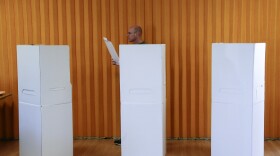NEW YORK — The sound of Peyton Manning barking "Omaha! Omaha!" is picked up by a tiny microphone in an offensive lineman's pads so it can be broadcast to the world.
In an age of enormous high-definition televisions and games streamed to tablets and smartphones, audio seems almost quaint. Yet TV executives have made it a major focus in recent years, for the exact reason so many people are fascinated by the Broncos quarterback's audibles.
"It makes you feel like you're right there," said John Entz, Fox Sports' executive vice president for production. "That's what fans crave these days."
NFL Films pioneered the use of in-game audio, and the league had long clipped a microphone to the umpire's cap to capture the snap count. Before the 2010 season, though, the ump's position on most plays shifted from the middle of the defense to well behind the offense for safety reasons.
After much experimentation during exhibition games, NFL officials decided to put a microphone in the back of the pads of two players for each team: either the first- and second-string centers or both starting guards.
NFL Films engineers at the game turn on one mic when the offense breaks the huddle, then shut it off after the ball is snapped. The audio is transmitted to the TV truck, where the networks mix it with crowd noise.
Technology has gradually improved over the years to make the calls sharper — and not only in microphones. Just as the spread of HD sets left fans entranced by the crisp pictures, more and more viewers enjoy state-of-the-art surround sound in their living rooms.
Meanwhile, TV executives have embraced the value of audio in hooking the audience, seeking more and better ways to use it. Video used to be the "fair-haired child," said CBS Sports executive vice president Ken Aagaard.
Not anymore.
"It's gotten to the point now that the audio experience on an NFL game, and even a college football game, is just as important as the video," said Aagaard, who oversees operations, engineering and production services.
Sitting in the truck Sunday in Denver as CBS broadcast the AFC championship game, Aagaard kept getting text messages and emails that "this audio is as good as they've ever heard." Still, Aagaard, who has heard plenty of "Omahas" from Manning over the years, isn't quite sure why the word became a social media sensation only the last couple of weeks.
Manning has been a snap count virtuoso dating to his Indianapolis days, his calls unusually loud, clear and long. Aagaard credited producer Lance Barrow and announcers Jim Nantz and Phil Simms for the silence in the booth during Manning's calls Sunday, letting the "Omahas" speak for themselves. Asked last week what the word meant, Manning gave a playful answer, not really revealing whether it referred to a pass, a run or a snap count.
Entz said Fox would "have some fun" with Manning's audibles in pregame features on Super Bowl Sunday, then talk about it during the game as is relevant. The opposing quarterback, Seattle's Russell Wilson, is also vociferous, said Fox's audio mixer, Fred Aldous. But Wilson's calls are shorter and less complex, possibly because he's much less experienced than Manning.
The QB's voice isn't the only reason the snap count comes across fuzzy or crisp. Stadium and weather conditions and crowd noise can interfere. On a cool night in an outdoor stadium, the sound travels better, said Howard Katz, the NFL's senior vice president of broadcasting and media operations.
Aldous' favorite venue is Green Bay's Lambeau Field, and not just because the air is usually chilly. All those bulky coats worn by shivering fans absorb sound, which makes his job easier. He wants each type of audio to be distinct, so he can then weave them together to create the perfect mix. In a dome, noises bounce off the hard surfaces and get muddled together.
In other words, Aldous is hoping for a cold Super Bowl when Fox televises the game in the elements in New Jersey.
As desirable as intelligible snaps counts are, Aldous tries to ensure they don't drown out everything else. The right amount of crowd noise is also crucial.
"We really don't want to take a viewer out of the stadium and put them right next to Peyton Manning — we want to make sure they stay in the stadium and keep the flavor in there," he said.
Each mixer for CBS has a different style, Aagaard said, though he's pushing for more uniformity. He can close his eyes while watching a broadcast and pick out who is working that game.
NFL Films also records plenty of additional audio during games, through microphones on other players and on the sidelines, which is repackaged for various shows that air later. The networks are always hoping for more sound, especially during games. Teams are always worried about giving away secrets.
There was some angst from clubs when the microphones were put on offensive linemen, said Katz, who is also chief operating officer for NFL Films. That surprised him because they were capturing the same audio the umpires' caps previously did. He notes that since defensive players can hear the snap count on the field, the offense isn't hurt by broadcasting it.
Aagaard would love to someday get sound on the defense's play calls, too. On all audio, the NFL must weigh the value to viewers against concerns over competitive advantages.
But the value is immense. Katz recalled the mantra of NFL Films' former president, the late Steve Sabol: "You feel with your ears."
Start with a close-up of a quarterback then add the sound of him hollering out calls, Aldous said, "and that takes it from good to awesome."





